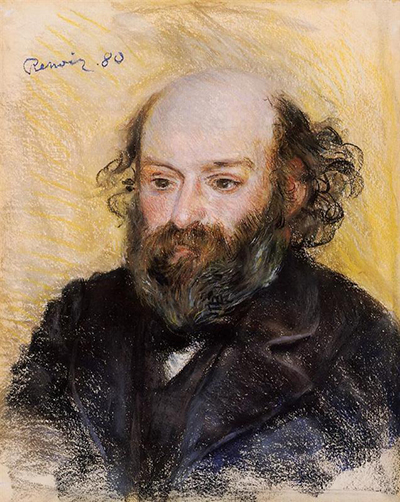Renoir's departure from Impressionism created a platform for other French artists like Paul Cezanne to follow suit
Paul Cezanne is a preeminent French artist associated with the Post-Impressionist period. In fact, he is credited with pioneering the advent of modern art of the twentieth century. Created in 1902, Pierre uses black colour to emphasise Paul’s beard, coat and bald head.
He then goes ahead to outline Paul’s form using the colour white to bring out other parts of the subject’s face. The painting is rather unique from the rest of Renoir repertoire as he does not use colourful palette; he also uses a dull shade for the background.
Renoir is remembered for his dexterity in painting portraiture, naked women and figurative work. He was among the first French Impressionists of his time. Though he focused on portraiture painting, his early work in the 1860s was characterised by en plein air painting where he worked alongside Claude Monet, Alfred Sisley and Frederic Bazille.
Later, Renoir departed from the traditional Impressionist style of capturing the fleeting effects of light and using bold brushstrokes. He embarked on portraiture borrowing from other renowned artists of his time. By the 1890s, Renoir’s paintings were characterised by the use of rich Titian and Ruben colours coupled with the sensual beauty of the 18th-century French art. Today, Renoir is celebrated as one of the greatest painters who introduced modern art.
Renoir’s Departure from Impressionism
The years 1881-1882 saw Renoir travel to Algeria, Provence and Italy, which is believed to influence the way he created subsequent paintings. He was convinced that following the Impressionistic painting style was no longer sufficient to bring out his impressions. Renoir was persuaded that the use of faint brushstrokes of contrasting colours that were outlined side by side restricted him to create the luminous effects of the skin.
It was then that he also discovered that black gave intensity to other shades compared to the accolade his peers gave to the colour. His pilgrimage to Italy was the most influential as it was then that he met Raphael who spawned his interest in classicism.
Renoir explored the beauty of drawing clear outlines to define a subject, and the effects of smooth painting when used to enhance the litheness of a body. A study of II librodell’arte by Cennino Cennini also made a great impact on his new painting style. Renoir felt deceived to have followed the empheral art for such a long time.
Evidently, subsequent paintings (1883-1884) took on a new discipline now dubbed the Ingres period. Renoir also retained a bit of Impressionism as he still used a luminous palette along with emphasis on form, volume, line and contours instead of brushstrokes and colour.
The expressionism which proved popular throughout the 20th century would spawn the likes of Rothko and Pollock.
Young Girls at the Piano - Here, Renoir shows two girls playing a piano in a middle-class home. The girl playing the piano is wearing a white dress with a blue stash while the other one is in a pink dress. At the time, Renoir’s financial situation had improved tremendously hence, most of his creations depicted his new security and confidence in the future.




